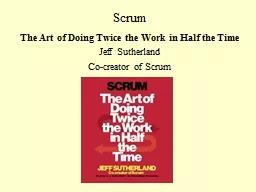PPT-Scrum History, Scrum Force Project & Scrum Injuries
Author : min-jolicoeur | Published Date : 2018-01-06
Dr Martin Raftery Background Scrums and the Game Scrum History 1982 2004 Over 20 year period a scrums per game have almost halved b scrum contest result unchanged
Presentation Embed Code
Download Presentation
Download Presentation The PPT/PDF document "Scrum History, Scrum Force Project &..." is the property of its rightful owner. Permission is granted to download and print the materials on this website for personal, non-commercial use only, and to display it on your personal computer provided you do not modify the materials and that you retain all copyright notices contained in the materials. By downloading content from our website, you accept the terms of this agreement.
Scrum History, Scrum Force Project & Scrum Injuries: Transcript
Download Rules Of Document
"Scrum History, Scrum Force Project & Scrum Injuries"The content belongs to its owner. You may download and print it for personal use, without modification, and keep all copyright notices. By downloading, you agree to these terms.
Related Documents














